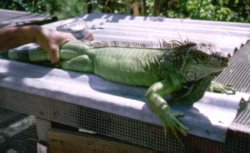
Melissa
Kaplan's
Herp Care Collection
Last updated
January 1, 2014
Green Iguana: Conservation and Consumption
New Agriculturist Online, 2001
|
Large lizards, which were hunted for food by our prehistoric ancestors, continue to be of importance in parts of Asia, Africa and Latin America. Monitor lizards are particularly popular in Asia but are carnivorous and therefore difficult to feed and raise economically. However, the green iguanas of Latin America are herbivorous, and, as a project in Costa Rica has shown, green iguanas in particular can be raised successfully in semi-captivity.
|
The green iguana (Iguana iguana), indigenous to Central America, has become extinct in some countries and is endangered in others as excessive hunting and destruction of their tropical forest habitat has depleted their numbers. The green iguana depends on trees - they feed primarily on leaves, flowers and fruits from the upper storey of the forest - but as species from the forest-edge, they can also do well on farms or ranches with forested areas.
In Costa Rica the FPIV (Fundación Pro Iguana Verde) continues to implement a conservation programme for green iguanas which began over fifteen years ago in Panama. The research, which has been generated from the raising of iguanas for releasing back into the wild, has also laid the practical foundations for iguana farming for local farmers. The ultimate goal of FPIV is to establish 'optimal conditions for sustainable production and marketing of the green iguana to benefit the small farmer' whilst also allowing natural populations to recover.
The cost of raising iguanas to usable size entirely in captivity is too high to be profitable so only adults required for reproduction are kept enclosed. Iguanas reproduce prolifically and mature females can produce up to 30 eggs per year for up to 10 years. The eggs, are laid in artificial nests (a sand-filled chamber) safe from predators to increase the number of hatchlings. These are then raised to 6-10 months old and then released into forests or farmland with scattered trees where the iguanas can grow to harvestable size within another two years. Supplementary feeding of 'iguana chow' (broken rice, meat, bone, fish meal and a variety of fruit, leaves and flowers) allows greater numbers to be supported in a given area e.g. around 50 adults/ha compared to 5-8/ha in the wild. From 200-300 kg/ha of meat can be harvested each year. With consumers willing to pay more for the meat than fish, poultry, pork or beef, iguana farming can provide an economic incentive to 'grow' lizards and not to fell forests to create more space for growing crops or cattle. Local farmers, who once hunted the iguana, are now learning how to raise them for food and for income generation in the production of leather handicrafts. Fat and eggs are also used for medicinal purposes.
“Iguana Park”, has also been established by FPIV near Oratina in Costa Rica as an eco-tourism facility and as an area to demonstrate and undertake further research on the sustainable use of forests. Dr Dagmar Werner, the founder and driving force behind the project, hopes that iguana farming can become part of Central American farming systems whilst also providing an incentive for reforestation. This in turn will help to counteract erosion, conserve water resources and enhance soil fertility. Although Costa Rica, Panama and Guatemala are the current target areas of the project, the potential for iguana farming could spread from tropical forested areas in Mexico down to northern areas of Brazil and Peru, and to a number of Caribbean islands.
Related Articles
Iguana Farming - A Source of Food and a Method of Tropical Forest Preservation
